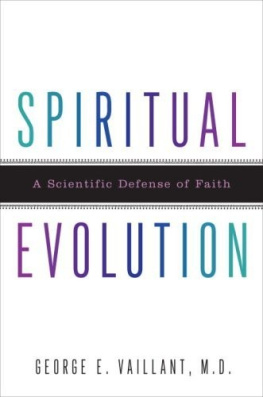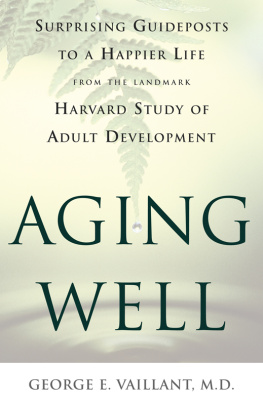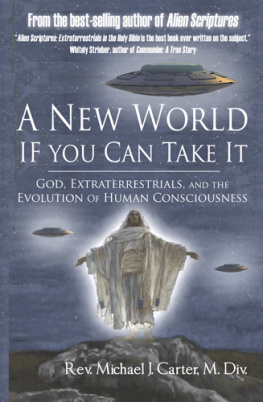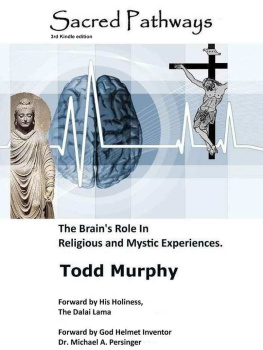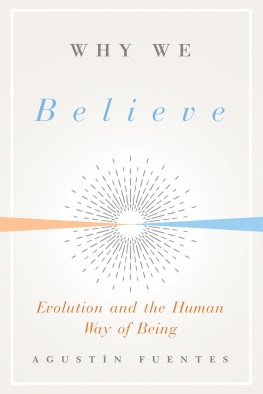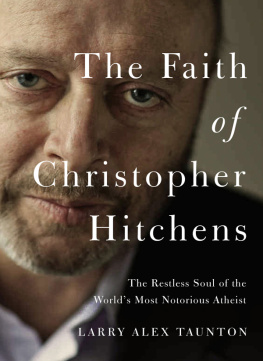
CONTENTS

For
S.B.V. (19081995)
In filial gratitude and love
I believe that I can see a direction and a kind of progress for life. If my hypothesis is correctwith their cyclical development horse, stag and tiger became like the insect, to some extent prisoners of the instruments of their swift moving or predatory ways. In the case of the primates, on the other hand, evolution went straight to work on the brain, neglecting everything else, which accordingly remained malleable.
P IERRE T EILHARD DE C HARDIN, The Phenomenon of Man
(London: Collins, 1959), pp. 14260
ACKNOWLEDGMENTS

This book has been twelve years in the writing and there are many to thank. James Lomax, MD, the wise and generative Baylor College of Medicine training director, provided the initial impetus for this book when he invited me to give five talks between 1994 and 2004 at the annual Psychotherapy and Faith Conference of the Institute for Religion and Health at the Baylor College of Medicine. The conference topics he assigned me were hope, love, faith, joy, and forgiveness, topics on which at that point I had not yet written a single word. Sometimes called the theological virtues, the topics were a gift, but for a psychiatrist they were a challenge. A generous and imaginative Texas philanthropist, Loise Wessendorff, underwrote the support for these psychiatric conferences.
During the same period I served as a Class A (nonalcoholic) trustee of Alcoholics Anonymous. For six years, AA members, too many to list, gently educated me in the fact that spirituality was about the language of the heart and not about the language of written words. After leaving AA, I passed into the equally generative hands of Martin Seligman in order to join the steering committee of the Center for Positive Psychology at the University of Pennsylvania, from 2001 to 2007.
I wish to acknowledge the generous support during the past twelve years of the National Institute of Mental Health, and also of the John Templeton Foundation. During the preparation of this book, from 2005 to 2007, the foundation underwrote six weeks a year at the Center for Positive Psychology and provided the resources to invite exciting guests such as Melvin Konner, Greg Fricchione, Stephen Post, and Robert Cloninger to ponder with me the relationship between mammalian evolution and human spirituality. The foundation also stimulated the books creation by inviting me to give the Templeton Research Lectures in Religion and Science at the University of Pennsylvania (20052006).
Along the way, many individuals critiqued the books eleven chapters. Among the particularly helpful readers were: Monika Ardelt, Dan Blazer, Maren Batalden, Brock Brower, Sara Coakley, William Clark, Debbie Cohen, Kirsten Cronlund, Mike Csikszentmihalyi, Greg Fricchione, Emily Greenfield, Diane Highum, Christine Howard, Kahlil Kahlil, Melvin Konner, Ernest Kurtz, Sue and Ilan Kutz, Irene Kontje, Ronald Lee, William Miller, Sue Mancie, Jenni Mariano, Mary McCarthy, Michael Morton, Jill Niemark, John Peteet, James Pritchard, Paulding Phelps, Stephen Post, Frank Robertson, Howard Spiro, Carolyn Spiro, Debbie Swick, Kathy Sanders, Martin Seligman, Janice Templeton, Anne Vaillant, Joanna Vaillant, and Phyllis Zagano.
Caroline Vaillant, Joanna Settle, Montgomery Brower, and Tom Kinder read drafts of the entire book. Their help was enormous.
Perhaps the greatest challenge was getting the book out of my brain and into readers hands. For this daunting task of translation I had four very gifted editors. The first agent to whom I showed the book, Jill Kneerim, read it carefully and then took me to lunch and the woodshed, for which I am very grateful. A year later, Laura Yorke, both editor and agent, generously provided me her orderly mind to help me outline and organize the text. Of equal importance, she placed the book with a mainstream New York publishing house and with a gifted editor, Amy Hertz. Amy passed along the book, which still needed clarity, to Kris Puopolo at Doubleday Broadway. Kris, a no-nonsense taskmaster, provided real focus by completing what Laura had begun. At last, coherent words were attached to my music.
Two other women were also essential to this book but in rather different ways. The first was Robin Western, who, when she was not protecting my writing time by looking after the Study of Adult Development (my day job) at Brigham and Womens Hospital, was generously retyping the drafts of this slowly evolving book. My deepest thanks go also to my wife, Caroline. For almost forty years she has been my model for the positive emotions of trust, love, hope, forgiveness, and compassion. If that were not enough, she has induced in me the reciprocal positive emotions of joy, love, and gratitude.

Positive Emotions

Lord, make me an instrument of your peace.
Where there is hatred, let me sow love.
Where there is injury, let me sow forgiveness;
Where there is doubt, let me sow faith;
Where there is despair, let me give hope.
Where there is sadness, let me give joy;
O Master, grant that I may not so much to seek compassion but to give compassion.
The Peace Prayer of St. Francis
ATTRIBUTED TO F ATHER E STHER B ECQUEREL (1912)

Just as a prism separates white light into a spectrum of discrete colors, so this book separates spirituality into a broad spectrum of positive emotions. By focusing on the positive emotions, I wish to perform for spirituality what the science of nutrition has performed for the worlds discordant diets. Just as nutrition identifies the vitamins and the four basic food groups that make other peoples peculiar ethnic diets nourishing, so neuroscience, cultural anthropology, and ethology identify the love, community building, and positive emotions that enduring religions have in common.
Heres a true story told by Jack Kornfield, a clinical psychologist. Traveling by train from Washington to Philadelphia, Dr. Kornfield found himself seated next to the director of a rehabilitation program for juvenile offenders, particularly gang members who had committed homicide.
One fourteen-year-old boy in the program had shot and killed an innocent teenager to prove himself to his gang. At the trial, the victims mother sat impassively silent until the end, when the youth was convicted of the killing. After the verdict was announced, she stood up slowly and stared directly at him and stated, Im going to kill you. Then the youth was taken away to serve several years in the juvenile facility.
After the first half year the mother of the slain child went to visit his killer. He had been living on the streets before the killing, and she was the only visitor [in jail] hed had. For a time they talked, and when she left she gave him some money for cigarettes. Then she started step by step to visit him more regularly, bringing food and small gifts. Near the end of his three-year sentence, she asked him what he would be doing when he got out. He was confused and very uncertain, so she offered to help set him up with a job at a friends company. Then she inquired about where he would live, and since he had no family to return to, she offered him temporary use of the spare room in her home. For eight months he lived there, ate her food, and worked at the job. Then one evening she called him into the living room to talk. She sat down opposite him and waited. Then she started, Do you remember in the courtroom when I said I was going to kill you? I sure do, he replied. Ill never forget that moment. Well, I did, she went on. I did not want the boy who could kill my son for no reason to remain alive on this earth. I wanted him to die. Thats why I started to visit you and bring you things. Thats why I got you the job and let you live here in my house. Thats how I set about changing you. And that old boy, hes gone. So now I want to ask you, since my son is gone, and that killer is gone, if youll stay here. Ive got room, and Id like to adopt you if you let me.1 And she became the mother he never had.
Next page
